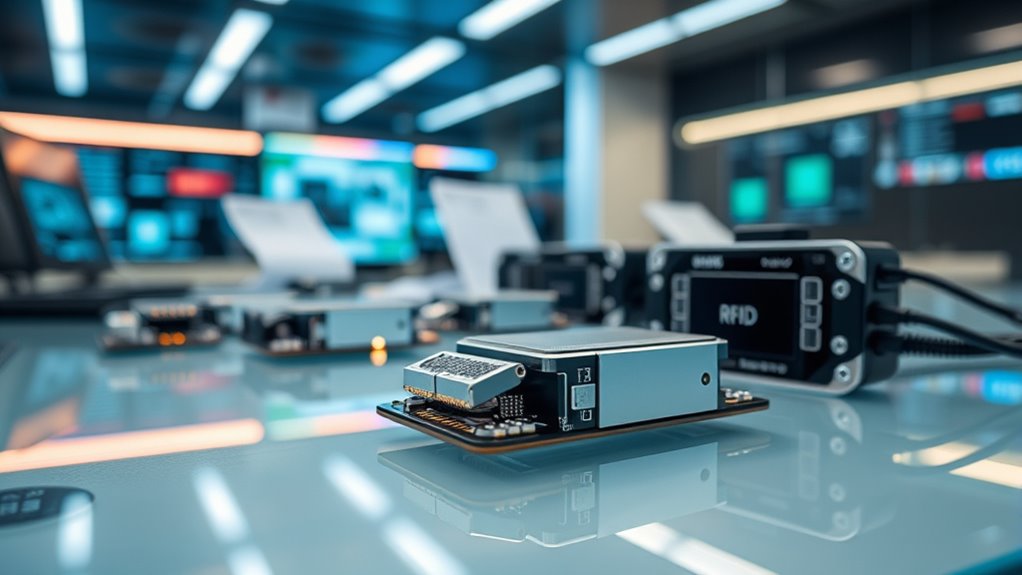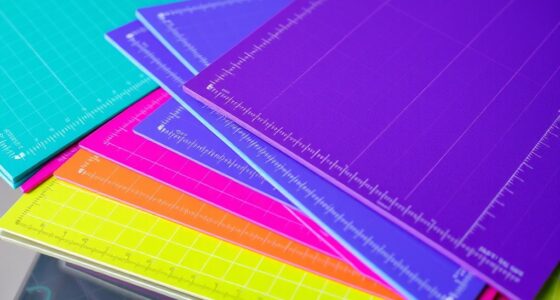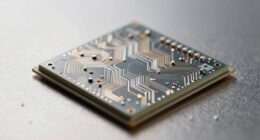If you’re looking for the top RFID cloning tools to enhance your security tests or perform ethical hacking, I can help. From handheld duplicators compatible with 125kHz chips to advanced multi-frequency devices supporting Bluetooth and software decoding, there are options for all skill levels. These tools are portable, easy to use, and great for quick cloning of non-secured RFID cards. Keep exploring to discover the best options and how to choose the right device for your needs.
Key Takeaways
- Handheld RFID duplicators support 125kHz chips like T5577, EM4100, enabling quick and portable cloning for security testing.
- Advanced multi-frequency devices with Bluetooth and multiple card slots offer versatile cloning and management options.
- Compatibility varies; ensure devices support specific chip types and understand limitations with encrypted or high-security RFID cards.
- Reusable and easy-to-use tools allow rapid duplication of access, parking, or switch cards in field applications.
- Consider device reliability, firmware updates, and proper command programming to maximize cloning effectiveness and security assessments.
Handheld RFID ID Card Duplicator for T5577 Keys and Cards (Includes 5 Keychains & 5 Cards)
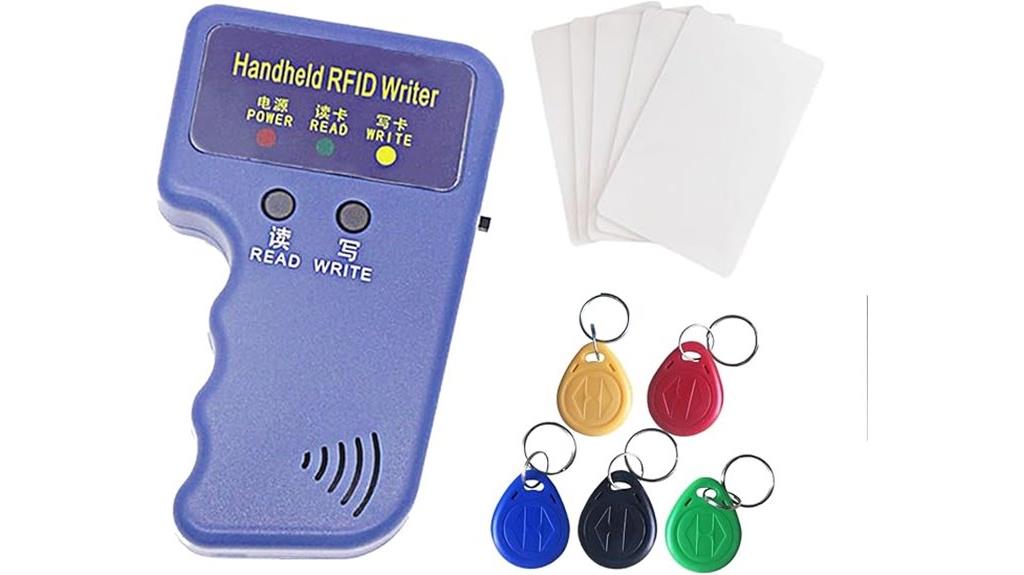
If you’re looking for a reliable handheld RFID duplicator that’s perfect for low-frequency cards and keyfobs, this device is an excellent choice. It’s designed for 125kHz RFID chips like T5577, EM4100, and TK4100, making it versatile for copying parking, access, or switch cards. Small and lightweight at just 56 grams, it offers simple operation—reading, writing, and copying with ease. You need to input commands from your device first, but once programmed, you can reuse it infinitely. The package includes five keychains and five cards, providing enough to get started. Just ensure chip compatibility before use for smooth functioning.
Best For: individuals or businesses needing a portable, easy-to-use solution for copying low-frequency RFID cards and keyfobs, such as access control or parking management.
Pros:
- Compatible with multiple low-frequency RFID chips including T5577, EM4100, and TK4100, offering versatility.
- Small, lightweight design (56g) makes it highly portable and convenient for on-the-go use.
- Reusable with a single command, allowing multiple copies after reprogramming, reducing ongoing costs.
Cons:
- Requires prior input of commands from your existing RFID device before copying; cannot read or write directly out of the box.
- Limited to one-time replication per command without reprogramming, which may slow down high-volume copying.
- Compatibility with certain chips like EM4100, EM4305, or TK4100 is not guaranteed; verification needed before purchase.
RFID Handheld ID Copier and Duplicator Kit with T5577 Cards and Keychains
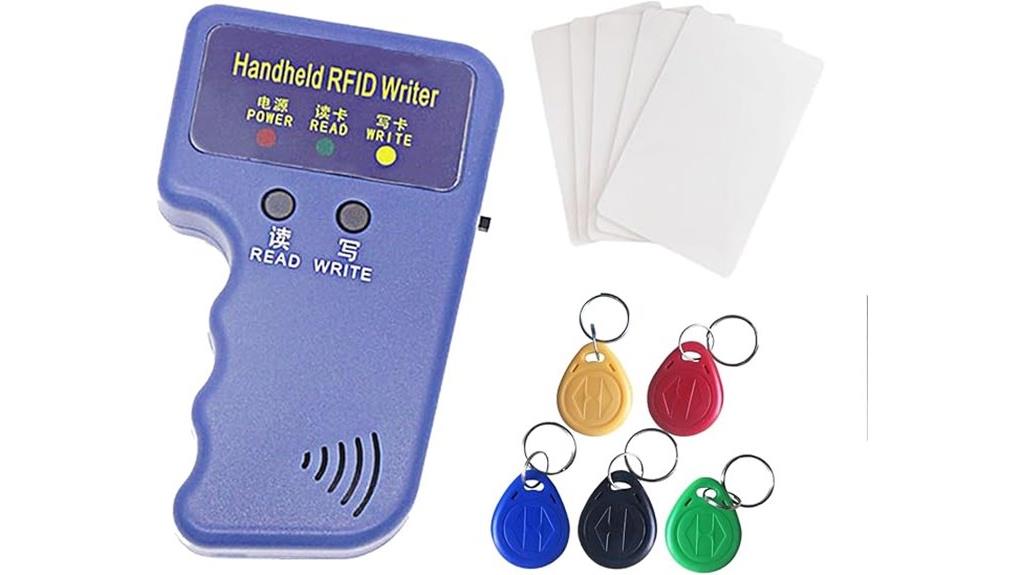
The RFID Handheld ID Copier and Duplicator Kit with T5577 Cards and Keychains stands out as an ideal choice for those seeking a compact, portable solution for copying low-frequency RFID access devices. Weighing just 56 grams, it’s easy to carry and operate on-site with two AAA batteries (not included). It supports all 125kHz RFID chips like T5577, EM4100, and TK4100, making it versatile for keyfobs, parking cards, and access devices. The device reads and writes RFID tags quickly—confirmation comes via buzzer and lights. While it requires proper command setup and isn’t compatible with higher-frequency devices, it offers a straightforward, efficient way to duplicate compatible RFID cards.
Best For: individuals or businesses needing a portable, easy-to-use solution for copying low-frequency RFID access cards and keyfobs on-site.
Pros:
- Compact and lightweight design for easy portability.
- Supports a wide range of 125kHz RFID chips including T5577, EM4100, and TK4100.
- Simple operation with quick read/write confirmation signals.
Cons:
- Compatible only with low-frequency RFID devices; cannot duplicate higher-frequency cards.
- Requires correct command setup before copying; not a plug-and-play solution.
- Some users report occasional failures or compatibility issues with certain RFID tags.
Handheld RFID Copier and Reader (125kHz, T5577, EM4305, 6 pcs T5577+6 Cards)
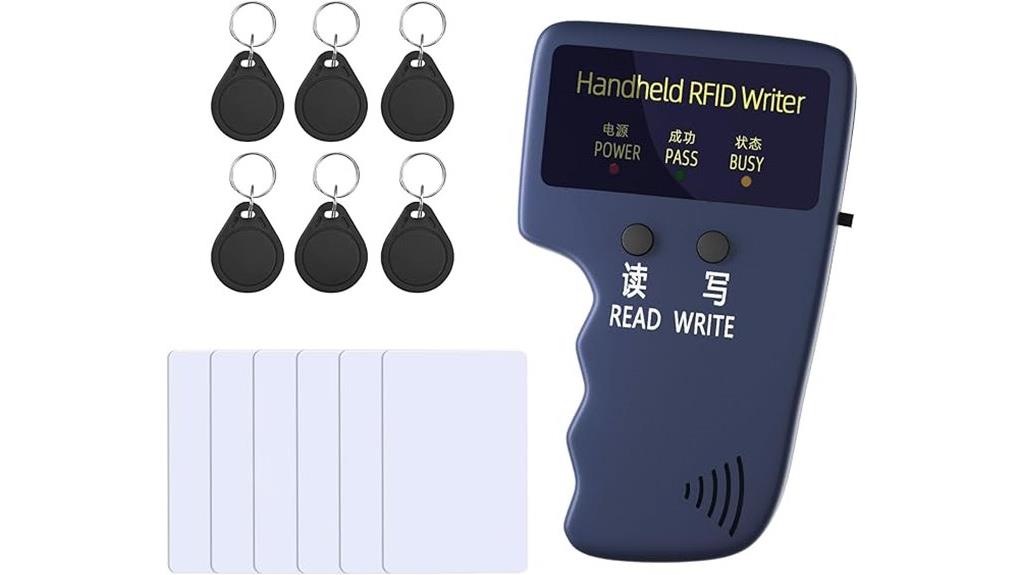
Designed for on-the-go use, the Handheld RFID Copier and Reader (125kHz, T5577, EM4305) stands out for its compact size and ease of operation, making it ideal for security professionals and hobbyists alike. Weighing just 56 grams, it’s lightweight and easy to carry, perfect for quick on-site copying tasks. Support for 125kHz cards, including common parking and access cards, ensures versatility. The device reads and writes data, enabling duplication and reuse of cards that are typically single-use. With its simple process—reading existing data before writing—it’s an efficient tool for expanding access or testing card security. Plus, it comes with six T5577 cards for immediate use.
Best For: security professionals, locksmiths, and hobbyists needing portable RFID card duplication and testing on-site.
Pros:
- Compact and lightweight design (56g) for easy portability and on-the-go use.
- Supports multiple 125kHz RFID cards, including common access and parking cards, offering versatility.
- Reusable duplication feature allows multiple uses of cards, saving cost and increasing efficiency.
Cons:
- Requires 2 AAA batteries, which need to be replaced or recharged for continuous operation.
- Default chips are blank; existing data must be read before writing, adding an extra step.
- Limited to 125kHz RFID cards; incompatible with higher-frequency or more complex RFID systems.
Keysy RFID Duplicator for Key Fobs and Cards
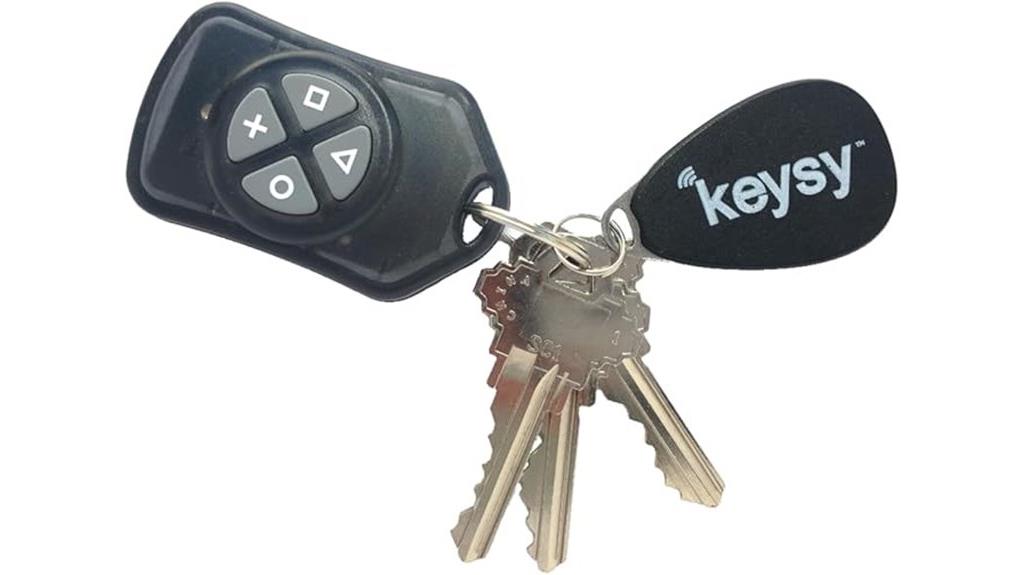
For those seeking an affordable and easy way to duplicate RFID key fobs and cards in-house, the Keysy RFID Duplicator stands out as a top choice. It can copy up to four 125kHz RFID credentials, including popular types like HID Prox and Indala, onto rewritable Keysy fobs. You can also emulate these credentials when accessing doors, though some readers may not support this. The device is simple to use, saving time and money by eliminating third-party duplications. Backed by a one-year warranty and customer support, it offers a secure way to manage access credentials yourself. Just remember to check compatibility with your door readers beforehand.
Best For: individuals or small organizations seeking an affordable, user-friendly solution to duplicate and manage RFID key fobs and cards in-house.
Pros:
- Enables quick duplication of up to four RFID credentials onto rewritable fobs, saving time and costs.
- Provides the ability to emulate credentials for access, enhancing convenience.
- Backed by a 1-year warranty and responsive US-based customer support for peace of mind.
Cons:
- Some RFID door readers may not support key fob emulation, limiting functionality.
- Only includes one rewritable key fob; additional fobs must be purchased separately.
- Compatibility with all RFID systems is not guaranteed; users should verify compatibility before purchasing.
Handheld 125kHz RFID Card Duplicator with T5577 and EM4305 Compatibility + 5 Keychains and Cards
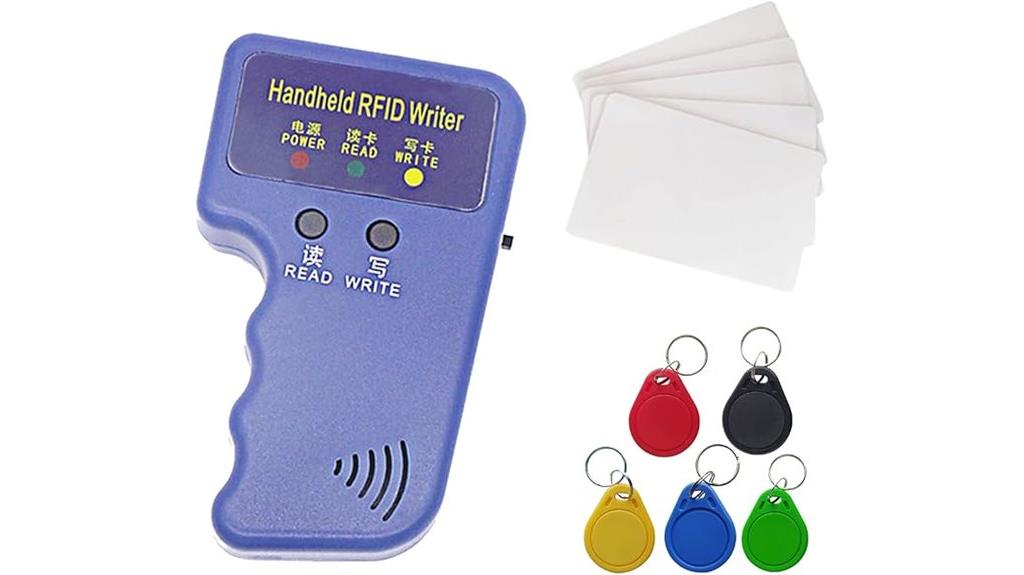
If you’re looking to duplicate low-frequency RFID cards and key fobs quickly and affordably, the Riversmerge Handheld 125kHz RFID Copier is a solid choice. It’s compatible with T5577, EM4100, EM4305, and TK4100 chips, making it versatile for copying parking cards, access badges, or small shaped cards. Weighing just 56g and powered by two AAA batteries, it’s portable and easy to use. Simply read the original card’s command, then write it to blank cards or keychains. While it works well with unencrypted cards, some users report inconsistent performance, so testing before full use is recommended.
Best For: individuals seeking an affordable, portable solution for duplicating common 125kHz RFID cards and key fobs for personal or access control use.
Pros:
- Compatible with multiple low-frequency RFID chips including T5577, EM4100, EM4305, and TK4100, offering versatility.
- Lightweight (56g) and powered by two AAA batteries, making it highly portable and easy to operate on the go.
- Cost-effective alternative to professional duplication services, allowing repeated use with proper instructions.
Cons:
- Inconsistent performance reported by some users, especially with encrypted or certain card types.
- Build quality and controls are perceived as cheap or confusing, which may affect ease of use and durability.
- Not suitable for encrypted or NFC cards, limiting its functionality to unencrypted 125kHz RFID cards and fobs.
Handheld RFID Card Copier with T5577/EM4305+6 Blue Keychains and 5 Cards
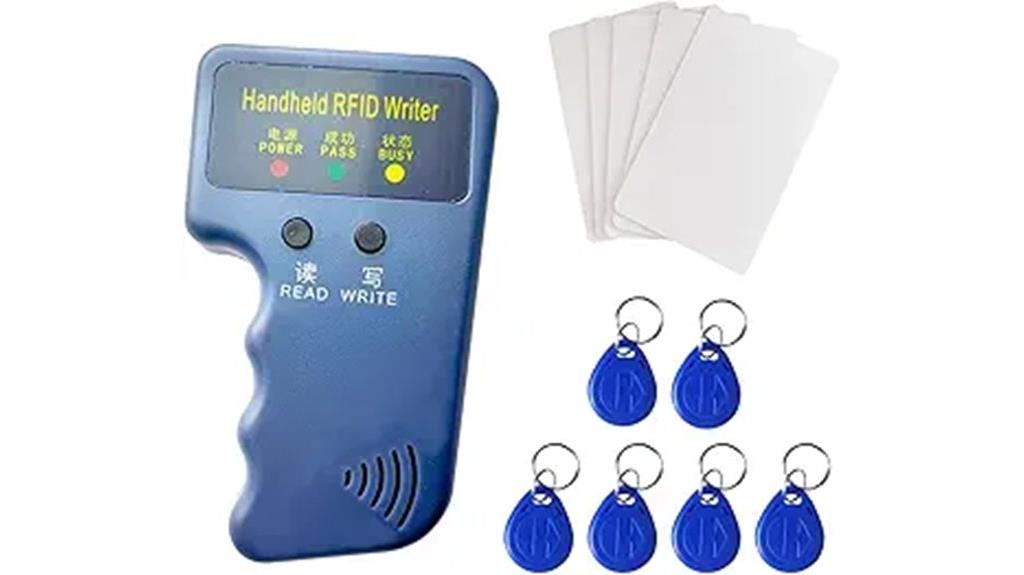
The Handheld RFID Card Copier with T5577/EM4305+6 Blue Keychains and 5 Cards stands out as an excellent choice for those seeking a portable and affordable solution to clone low-frequency RFID cards. It’s compact, lightweight, and powered by two AAA batteries, making it perfect for on-the-go use. Designed for 125kHz cards like parking, access, and switch cards, it can read and clone these tags with simple touch controls. While it requires user programming of commands, it offers powerful, one-time duplication. The package includes six blue keychains and five cards, providing everything needed to quickly replicate and reuse RFID access credentials.
Best For: DIY enthusiasts, security professionals, and anyone needing a portable, cost-effective solution for cloning low-frequency RFID cards on the go.
Pros:
- Compact, lightweight, and battery-powered for easy portability
- Compatible with popular 125kHz RFID chips like T5577 and EM4305
- Simple touch controls and quick cloning process suitable for quick on-site duplication
Cons:
- Requires user programming of commands; not plug-and-play out of the box
- Limited to low-frequency RFID cards; incompatible with higher frequency devices
- Some users report responsiveness issues, occasional failure to read/write, or device faults
RFID Reader Writer Full Function RFID Emulator and Copier

The Chameleon Ultra stands out as an all-in-one RFID emulator, reader, writer, and copier, making it an essential tool for security professionals and hobbyists alike. It supports dual frequencies—125kHz and 13.56MHz—allowing compatibility with a wide range of cards, including access and NFC tags. With eight card slots, it can simulate multiple cards simultaneously, streamlining system testing and replacements. Its compact design fits easily in your pocket, and Bluetooth connectivity ensures quick, on-the-go management via smartphones. While it excels in cloning and emulation, it doesn’t support full encryption cards, and firmware stability can be an issue.
Best For: security professionals, hobbyists, and system testers seeking a versatile, portable RFID cloning and emulation device for various access control systems.
Pros:
- Supports dual frequencies (125kHz and 13.56MHz) for broad card compatibility
- Can simulate multiple cards simultaneously with 8 dedicated slots
- Compact, lightweight design with Bluetooth connectivity for convenient, on-the-go use
Cons:
- Does not support full encryption cards with scrolling codes
- Firmware updates are unstable and may cause operational issues
- Requires original cards for copying, not a universal card device
Handheld RFID Card Duplicator with 5 Write Cards and Keychains

A handheld RFID card duplicator with 5 write cards and keychains stands out as an ideal choice for security professionals, hobbyists, or anyone needing portable and reliable cloning capabilities. It’s compatible with all low-frequency 125kHz RFID tags with T5577 chips, including hidden, parking, access, and switch cards. The device is lightweight at just 56 grams, making it perfect for on-site use. It supports continuous read-write operations, with reusable cards and keychains that can be rewritten endlessly. To function correctly, you need to read your device’s commands first, then write to blank cards or keychains. Always verify chip type before purchase to ensure compatibility.
Best For: security professionals, hobbyists, and on-site users needing reliable, portable RFID cloning and duplication capabilities.
Pros:
- Compatible with all low-frequency 125kHz RFID tags with T5577 chips, including various card types and hidden cards.
- Lightweight and portable at only 56 grams, suitable for on-the-go use.
- Supports continuous read and write operations with reusable cards and keychains, allowing for multiple copies and flexible applications.
Cons:
- Not compatible with EM4100, EM4305, or TK4100 chip types despite operating at the same frequency.
- Requires prior reading of device commands before writing, which may be confusing for beginners.
- Limited to low-frequency 125kHz RFID tags with T5577 chips; cannot clone other chip types or high-frequency RFID systems.
RFID Handheld ID Copier and Duplicator with T5577 Keychains and Cards
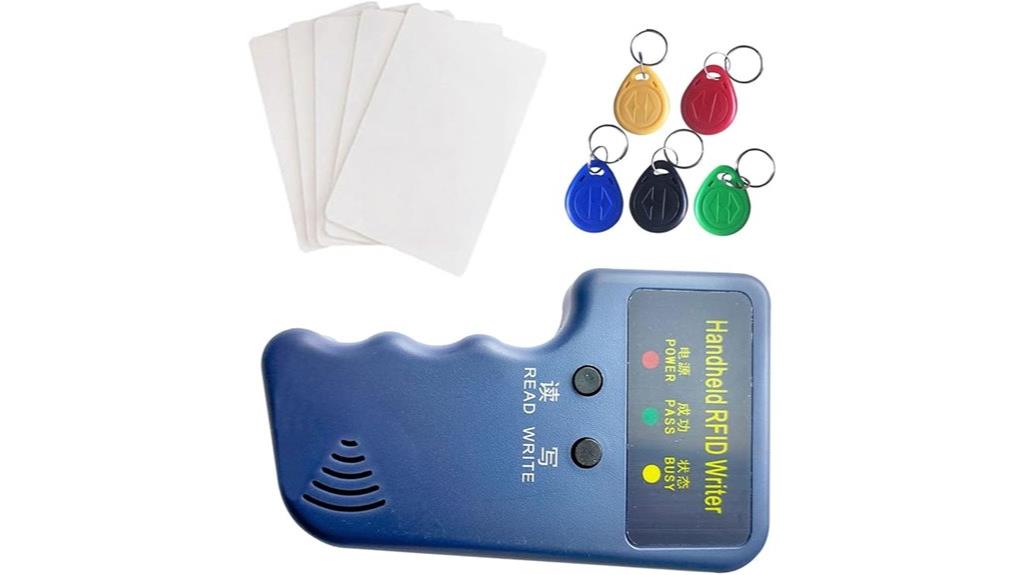
If you’re looking to clone low-frequency RFID cards quickly and reliably, the RFID Handheld ID Copier and Duplicator with T5577 Keychains and Cards stands out as an excellent choice. This compact device works with 125kHz RFID products, including T5577, EM4100, EM4305, and TK4100 chips, though confirming chip type is essential. It’s portable, wireless, and easy to use—simply place your card in the induction area, press read, then place a blank card and press copy. The device can be reused infinitely after programming once, making it ideal for copying parking, access, or small RFID cards. Powered by two AAA batteries, it’s perfect for on-the-go duplication.
Best For: individuals or businesses seeking a portable, reliable solution for quick low-frequency RFID card duplication and cloning on the go.
Pros:
- Compatible with multiple low-frequency RFID chips like T5577, EM4100, EM4305, TK4100 (confirmation recommended).
- Reusable infinitely after a single programming, allowing multiple copies from one programmed card.
- Compact, lightweight, wireless design powered by 2 AAA batteries for easy portability and on-site use.
Cons:
- Cannot be used directly without initial programming; requires compatible device instructions to write low-frequency commands.
- Limited to 125kHz RFID products; not compatible with high-frequency (13.56MHz) cards or other chip types without confirmation.
- Customer ratings are modest (3 out of 5 stars), indicating potential variability in performance or user satisfaction.
RFID ID Duplicator Copier Writer with NFC and T557 125kHz

For those looking to duplicate RFID and NFC cards with ease, the RFID ID Duplicator Copier Writer with NFC and T557 125kHz stands out as a versatile choice. It supports a wide range of cards, including T5577 and various writable chips, and can decode certain encrypted cards through Windows software. While it can’t handle secured access cards like MF1 or EM4100, it’s effective for copying UID and FUID tags, key fobs, and blank writable cards. The device requires a Windows PC and offers straightforward copying, making it suitable for users comfortable with software decoding. Its mixed reviews highlight both its capabilities and limitations in real-world applications.
Best For: DIY enthusiasts, security professionals, or small business owners seeking an affordable, versatile RFID cloning solution for non-secured cards and tags using Windows-compatible software.
Pros:
- Supports a wide range of writable RFID and NFC cards, including T5577 and UID/FUID tags.
- Capable of decoding certain encrypted cards via Windows software for advanced users.
- Compact and lightweight design makes it portable and easy to operate.
Cons:
- Cannot read or clone secured or encrypted access cards such as MF1 S50 or EM4100.
- Requires a Windows PC and software setup, with no standalone or macOS support.
- No keypad or display for direct code editing; limited functionality for advanced customization.
RFID Handheld 125kHz Copier with 5 Cards and Keychains

The RFID Handheld 125kHz Copier with 5 Cards and Keychains stands out as an ideal choice for security enthusiasts and professionals who need a compact, portable device that can copy all standard 125kHz RFID cards. It’s designed for T5577 and EM4305 chips, compatible with parking, access, and switch cards, including irregular shapes. Weighing just 56g, it supports direct copying, reading, and writing functions, but requires programming with an empty instruction chip first. With proper command input, it can be reused infinitely. The package includes five rewrite cards, two keychains, and a leather case, making it convenient for on-the-go use.
Best For: security professionals and enthusiasts who need a portable, versatile RFID copying device for low-frequency cards including irregular shapes.
Pros:
- Supports multiple low-frequency RFID chips including T5577 and EM4305, ensuring broad compatibility.
- Compact and lightweight design (56g) with included accessories like rewrite cards, keychains, and a leather case for easy portability.
- Reusable with proper command programming, providing cost-effective long-term use.
Cons:
- Cannot read or write cards directly without prior programming of low-frequency commands.
- Requires user to have knowledge of RFID command writing and programming for effective operation.
- Needs two AAA batteries, which must be replaced periodically for continued use.
X7 NFC RFID Card Copier and Reader Writer Kit

The X7 NFC RFID Card Copier and Reader Writer Kit stands out for its multi-frequency support, making it a versatile tool for cloning a wide range of RFID cards. It works with frequencies from 125KHz up to 13.56MHz, supporting various card types like S50, HID Prox, and T5577 keyfobs. The device features a 2.8-inch color TFT screen, simple keypad, and app connectivity, allowing easy operation and software updates. Compact and rechargeable, it’s suitable for quick, on-the-go cloning of non-encrypted cards. While it’s user-friendly and affordable, it struggles with encrypted or high-security cards and can have software issues, so manage expectations accordingly.
Best For: hobbyists and non-encrypted RFID users seeking an affordable, portable solution for cloning a variety of low- to mid-frequency RFID cards.
Pros:
- Supports multiple frequencies (125KHz to 13.56MHz), offering broad card compatibility
- Compact, lightweight, and rechargeable for easy on-the-go use
- User-friendly with a color TFT screen and app connectivity for straightforward operation
Cons:
- Limited support for encrypted or high-security RFID cards
- Software issues and non-intuitive interface can complicate usage
- Build quality and durability may be subpar for heavy-duty or professional use
RFID Copier RFID Reader Writer Multi-Frequency RFID Card Reader
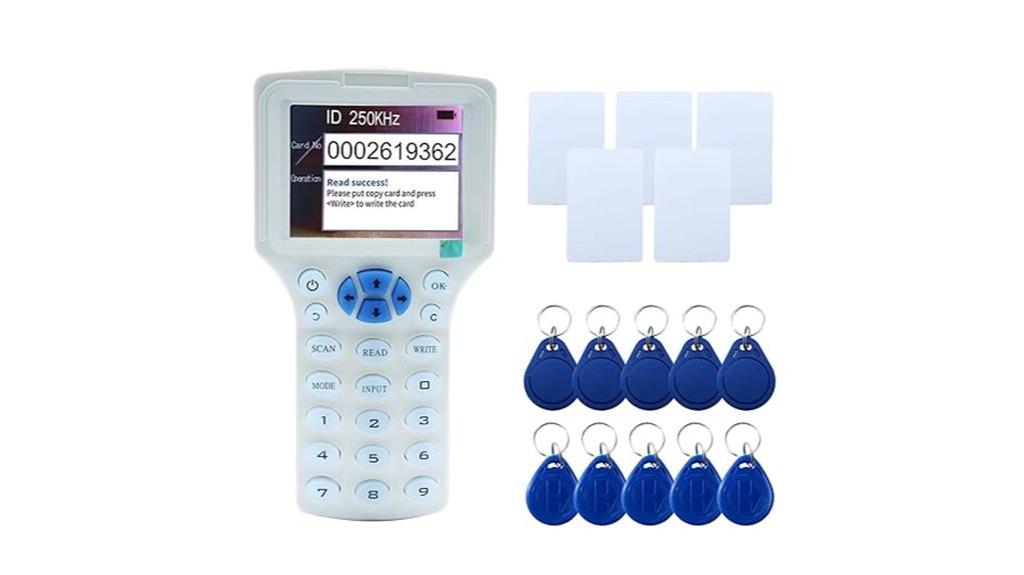
If you’re looking for a versatile RFID cloning tool that supports multiple frequencies, the RFID Copier RFID Reader Writer is an excellent choice. It can clone cards across a wide range of frequencies, including 125KHz up to 13.56MHz, making it compatible with access control, elevator, attendance, and parking cards. The device features a clear 2.75-inch HD screen, supports multiple languages, and offers flexible power options via batteries or USB. With simple operation—selecting frequency or auto-scan—you can easily read and duplicate card numbers. It’s especially useful for managing access credentials, though it doesn’t clone stored card data, only the card number.
Best For: individuals or organizations needing a versatile, multi-frequency RFID card cloning device for managing access control, elevator, attendance, and parking systems.
Pros:
- Supports a wide range of frequencies from 125KHz to 13.56MHz, ensuring broad card compatibility.
- Features a clear 2.75-inch HD color screen and multilanguage support for easy operation.
- Flexible power options via batteries or USB make it portable and convenient for various settings.
Cons:
- Can only clone card numbers, not stored data or full card information, limiting functionality with some cards.
- Some users report issues such as malfunctioning buttons or difficulty reading certain fobs.
- Quality control concerns and limited success with encrypted or complex security cards may affect reliability.
Factors to Consider When Choosing RFID Cloning Tools

When selecting an RFID cloning tool, I focus on compatibility with different card types and the supported frequencies and ranges. Ease of use, along with reliable software updates, is also essential for smooth operation. Additionally, I consider durability and portability to guarantee the device fits my needs in various scenarios.
Compatibility With Card Types
Choosing the right RFID cloning tool means guaranteeing it supports the specific chip types and frequencies of your cards. I always check if the device can read chips like T5577, EM4100, or EM4305 because compatibility with these chips ensures accurate cloning. It’s also essential to verify that the operating frequency matches my cards—most operate at 125kHz or 13.56MHz. Not all tools can handle encrypted or secured RFID tags, so I confirm whether the device can read protected cards if needed. Additionally, I consider whether the tool supports various card shapes and sizes, especially for irregular or hidden chips. Finally, I review if the device adheres to the protocols used by my RFID cards to guarantee proper copying and functionality.
Frequency Support and Range
Supporting the correct frequency is essential because RFID cloning tools must match the card’s operational frequency to function properly. Most cards operate at 125kHz for low-frequency or 13.56MHz for high-frequency devices. Choosing a tool that supports multiple frequencies increases versatility, especially if you need to clone different card types, including dual-frequency ones. Range support is equally important, as it determines how close the device needs to be to read or copy signals accurately. Longer ranges make the process easier and more efficient, particularly in complex environments. Some advanced tools can even handle encrypted or semi-encrypted cards within specific frequency ranges. Ensuring the device supports your target card’s frequency prevents compatibility issues and guarantees reliable cloning.
Ease of Use and Setup
Selecting an RFID cloning tool that’s easy to operate can save you time and frustration. Look for devices with user-friendly interfaces, like simple buttons, clear indicators, or touch controls, to make the process straightforward. Choose tools that require minimal setup, ideally with clear instructions for reading, programming, and writing RFID tags, so you won’t get bogged down with complex configurations. Quick initialization or plug-and-play functionality can substantially reduce the time needed to start cloning. Additionally, check if the device comes with detailed manuals or software that guides you step-by-step through the process, making learning smoother. Reliable power options, such as rechargeable or easy-to-install batteries, also help keep your workflow uninterrupted, ensuring ease of use from start to finish.
Software and Firmware Updates
Keeping your RFID cloning device up-to-date with the latest software and firmware is vital for reliable performance. Regular updates ensure compatibility with new RFID card types and security protocols, minimizing operational failures. Updated firmware can fix bugs, improve device stability, and boost copying accuracy, especially with encrypted or high-security cards. Manufacturers typically release updates through official websites or dedicated apps, so it’s important to verify their legitimacy to prevent security risks. Updating firmware might require connecting your device to a computer or using specialized software, so following the correct procedures is necessary for proper installation. Using the latest software versions also extends your device’s lifespan and helps maintain peak performance in an ever-evolving RFID environment. Staying current ensures your tool remains effective and secure.
Durability and Portability
When choosing an RFID cloning tool, durability and portability are essential factors that directly impact its performance and convenience. A robust device made from high-quality materials can withstand frequent use, accidental drops, and tough environments, guaranteeing consistent results over time. This reliability reduces the need for repairs or replacements. Portability is equally important; a lightweight, compact design allows me to carry the device easily during on-site tasks without sacrificing functionality. Rechargeable batteries and power-efficient features extend operational time in the field, eliminating the hassle of constant power access. Striking a balance between durability and portability ensures the tool remains reliable during rigorous use while remaining easy to transport and operate in various locations, making it an invaluable asset for both security and hacking purposes.
Frequently Asked Questions
What Are the Legal Implications of Using RFID Cloning Tools?
Using RFID cloning tools without permission can lead to serious legal trouble, including criminal charges like theft or unauthorized access. I always remind myself to use these tools responsibly and ethically, respecting privacy and property rights. Unauthorized cloning is illegal in many jurisdictions, so I recommend only using them for legitimate purposes like security testing with proper consent. Ignoring these laws could result in fines, lawsuits, or even jail time.
How Do RFID Frequencies Affect Cloning Device Compatibility?
Imagine RFID frequencies as busy highways, guiding data swiftly to its destination. I’ve found that cloning device compatibility hinges on matching these frequencies precisely. If your device operates at 125 kHz, it won’t work with a 13.56 MHz system. So, I always check the frequency before attempting to clone—it’s like ensuring your vehicle fits the road, avoiding crashes and ensuring smooth data transfer every time.
Can RFID Clones Be Detected by Security Systems?
Yes, RFID clones can sometimes be detected by security systems, but it depends on the system’s sophistication. Modern security often includes anti-cloning measures, like signal encryption and anomaly detection, making it harder to slip a clone past. I recommend staying vigilant and using multiple layers of security. If you’re concerned, consider implementing advanced RFID systems with real-time monitoring to catch suspicious activity promptly.
What Is the Typical Range for Handheld RFID Duplicators?
Handheld RFID duplicators typically have a range of about 1 to 10 centimeters, depending on the device and the RFID tag’s frequency. I’ve observed that most are designed for close proximity use, making it easy to scan or clone RFID cards within a few centimeters. This limited range helps *guarantee* precise data capture but also means you need to be quite close to the target to operate effectively.
How to Ensure Data Security During RFID Cloning Processes?
The proof is in the pudding—security during RFID cloning is vital. I make sure to encrypt data before cloning, use secure channels, and work in controlled environments. It’s necessary to stay updated on vulnerabilities and follow best practices. Regularly changing access credentials and monitoring for suspicious activity keep risks at bay. Think of it as locking all doors and windows before leaving; prevention is always better than cure.
Conclusion
Choosing the right RFID cloning tool means selecting one that’s reliable, versatile, and easy to use. It’s about matching your needs with the features, understanding the compatibility, and considering the ease of duplication. Whether you want to boost security or explore the tech, find a tool that’s straightforward, effective, and adaptable. Because the right RFID cloning device isn’t just about copying; it’s about empowering your confidence and expanding your possibilities.
